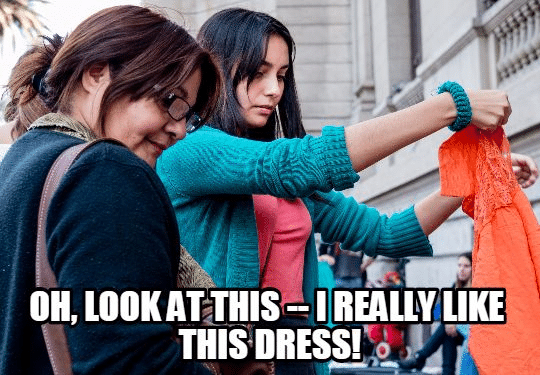4.9 – líbit se – liking something
|
|
|
Ok, now we are going to learn how to say we like something. But wait…
|
|
Yes and no. We did learn mám rád(a)… when we wanted to say we like things, e.g. –
Mám ráda čokoládu. I like chocolate.
Nemám rád, když prší. I don’t like when it rains.
Máme rádi klasickou hudbu. We like classical music. |
So in the examples above and the ones we’ve used so far, the thing we liked has typically been something we’re more invested in, i.e. our favorite foods, our preferred type of music, what we like to do (or don’t like to do), what kind of weather we like, etc. These are things that we experience all the time and can form general opinions about.
But what about something new, something we’re just experiencing now and we want to say that we like it. A friend walks in and you say “I really like your earrings!” or your roommate walks in with a new (excellent!) jacket and you say “I really like your jacket!”. These are more like our basic impressions, not some sort of liking that we’re invested in or is a longtime sort of liking. We’re going to be talking about that kind of liking now and we’ll use the verb líbit se.
líbit se
First, take a look at these sentences:
Líbí se mi ten svetr.
I like that sweater.
Líbí se mi tvoje boty.
I like your shoes.
Nelíbí se mi ta hudba.
I don’t like that music.
To understand how the verb líbit se works, it might be easier to roughly translate it as ‘to be pleasing’. So in the above examples, you would be literally saying ‘that sweater is pleasing to me’, ‘your shoes are pleasing to me’, ‘that music is not pleasing to me’.
The thing that you like is actually the subject of the sentence (it is pleasing to me / they are pleasing to me) and this is why the ending that you see on the verb líbit se is -í in the examples above. You’re using the 3rd person forms, we all know the verb endings very well at this point, but just for review, compare the endings for -í- verbs:
|
(já) |
-ím |
(my) |
-íme |
|
(ty) |
-íš |
(vy) |
-íte |
|
(on/ona/ono) |
-í |
(oni/ony/ona) |
-í |
Ok, so the thing you like (is pleasing to you) is the subject of the sentence, so how do you express who likes it (i.e. to whom it is pleasing)? Well, for this you’re going to need a few new forms, but don’t worry, they’re not that hard.
Take a look at the concept of case lesson if you need a refresher. We won’t learn every last form of the dative now, but just the forms that we’ll need to talk about who likes what, etc.
|
|
MA |
F |
|
Hard Stem |
-ovi Jan → Janovi Petr → Petrovi
|
-e / -ě
Aneta → Anetě Karolína → Karolíně
sound changes: k → c, r → ř (also h → z, ch → š, but those are less common in names so won’t be important here).
Some examples: Veronika → Veronice Sára → Sáře
|
|
Soft Stem |
-ovi Lukáš → Lukášovi Tomáš → Tomášovi |
-i Lucie → Lucii Marie → Marii |
So for Masculine Animate the ending is -ovi regardless of whether it’s hard or soft, while for Feminine it’s -e/-ě
Let’s take a look at some examples:
Haně se líbí moje nová košile.
Hana likes my new shirt.
Lukášovi se líbí ten svetr.
Lukáš likes that sweater (that sweater is pleasing to Lukáš).
Notice that for each of these, the person who likes the thing is in the dative case (it is pleasing to them)
You might also want to use pronouns (me, you, him, her, etc.). For that you’ll need…
Dative of Pronouns
The table below gives the dative forms of personal pronouns next to the nominative forms that we already know:
|
nominative form |
dative form |
|
já |
mi, mně |
|
ty |
ti, tobě |
|
on |
mu, jemu |
|
ona |
jí |
|
my |
nám |
|
vy |
vám |
|
oni (ony, ona) |
jim |
Remember that se is going to be in 2nd position. When you use these pronoun forms, put them right after the word se (they are also technically in 2nd position, but get outranked by se)
Líbí se ti ta šála?
Do you like that scarf?
Nelíbí se mi ty džíny.
I don’t like those jeans.
Líbí se vám ta hudba?
Do you all like that music?
Notes:
- Several of these will probably seem familiar from chapter 1 (it’s been a while, I know!) from when we answered the question Kolik je ti let? / Kolik je vám let? ‘How old are you?’ and we answered Je mi dvacet let ‘I’m twenty years old.’ So it turns out you were already using the dative forms without knowing it.
- So when is it -e and when is it -ě? A few ways to help learn when to write it:
- -ě is written only after consonants that have a soft pronunciation when followed by -ě
- t, d, n (dental consonants)
- b, p, v, m (labial consonants)
- if there was a consonant mutation (k → c, r → ř, h → z, ch → š), then it’s just plain –e (consonant mutations are actually an extreme type of softening)
- this ultimately will just leave us with s, l, and z as the consonants that neither soften or mutate. Of course being in such a small group often makes them seem weird or a bit SLeeZy, right?
Images used in this document come from these sources.



